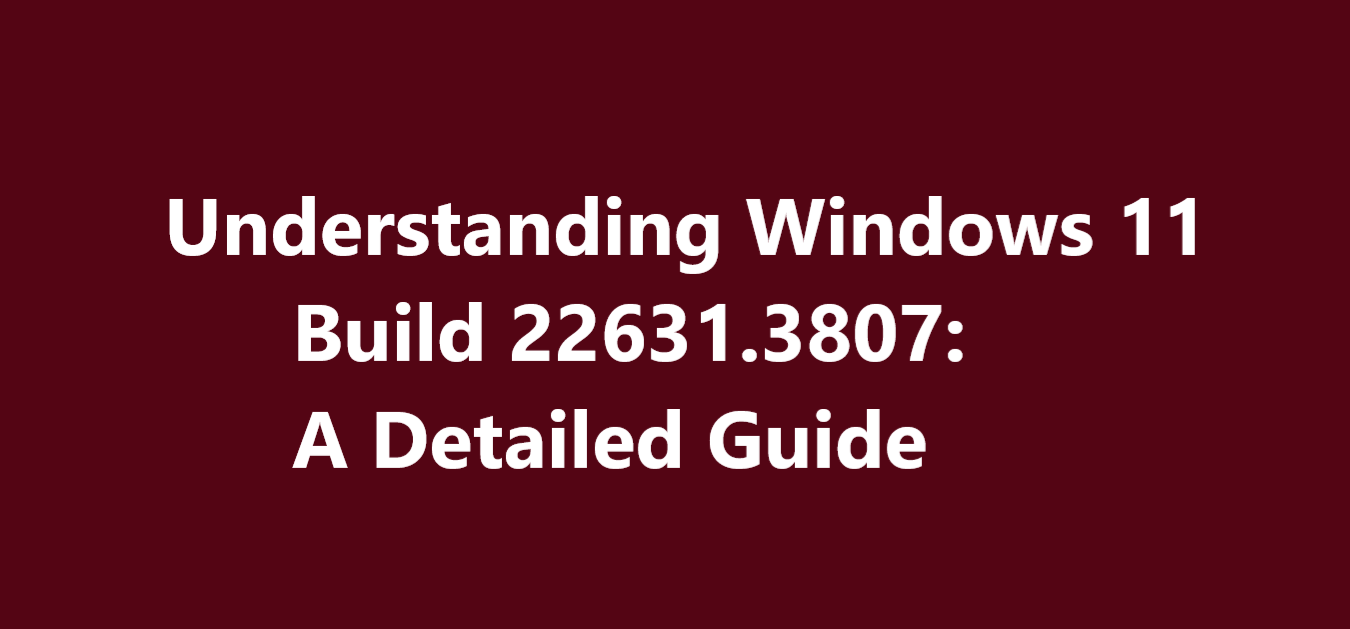Windows updates are crucial for keeping your computer secure, efficient, and up-to-date. One important update is Windows 11 Build 22631.3807. This article will explain what this build is, its features, how to install it, and potential issues you might encounter.
What Is Windows 11 Build 22631.3807?
Windows 11 Build 22631.3807 is a specific version of the Windows 11 operating system. Microsoft releases these builds regularly to fix bugs, enhance security, improve performance, and sometimes introduce new features. Each build is identified by a unique number, and in this case, it’s 22631.3807.
Key Features of Build 22631.3807
Build 22631.3807 includes several important updates and improvements. Let’s explore these features in detail.
1. Security Enhancements
Security is a top priority for Microsoft. Build 22631.3807 likely includes patches for security vulnerabilities that could have been exploited by hackers. These patches help protect your computer from threats like viruses, malware, and other cyberattacks.
2. Performance Improvements
This build might include tweaks that make your computer run faster and more smoothly. Performance improvements can lead to quicker boot times, faster application launches, and better overall system responsiveness. This means you’ll experience fewer delays when working on your computer.
3. Bug Fixes
Build 22631.3807 addresses various bugs that users may have reported in previous versions of Windows 11. These fixes can range from minor visual glitches to more serious issues that cause programs to crash or behave unpredictably. Bug fixes help ensure that your system runs as intended.
4. New Features
While not all builds introduce new features, some do. Build 22631.3807 might add new tools, settings, or enhancements to existing features. New features can improve your experience with Windows 11 by offering new ways to interact with the operating system.
5. User Interface Tweaks
Microsoft often makes small adjustments to the user interface with new builds. These tweaks might involve changes to icons, menus, or other visual elements, making the system easier and more pleasant to use.
How to Install Windows 11 Build 22631.3807
Installing Build 22631.3807 is a straightforward process. Windows updates are typically managed through the Windows Update feature. Here’s how you can ensure you have the latest build:
1. Check for Updates
- Open the Start Menu and click on Settings.
- Navigate to Update & Security and then select Windows Update.
- Click on Check for updates. If Build 22631.3807 is available, it will appear in the list of updates.
2. Download and Install the Update
Once the update is available, Windows will automatically download it. After downloading, you’ll need to restart your computer to complete the installation. Remember to save any open work before restarting to avoid losing data.
3. Verify Installation
After your computer restarts, you can check that Build 22631.3807 has been installed:
- Go to Settings > Update & Security > Windows Update.
- Click on View update history. You should see Build 22631.3807 listed among the installed updates.
Potential Issues with Build 22631.3807
While updates like Build 22631.3807 are designed to improve your system, they can sometimes introduce new problems. Here are some potential issues you might face:
1. Installation Failures
Sometimes, updates don’t install correctly. If this happens, you might see an error message. Common reasons for installation failures include insufficient disk space, conflicts with other software, or corrupted files. Restarting your computer and trying again can often resolve the issue.
2. Compatibility Issues
New builds can occasionally cause compatibility issues with existing software or hardware. If you notice that certain programs or devices stop working after installing Build 22631.3807, you may need to update those programs or drivers to ensure compatibility.
3. System Slowdowns
Although updates are typically designed to improve performance, there’s a chance that your system might slow down after installing a new build. This could be due to increased resource usage or conflicts with existing software. Monitoring your system’s performance after the update can help identify any issues.
4. New Bugs
Occasionally, a new build might introduce new bugs. If you encounter new problems that didn’t exist before, you can report them to Microsoft. They will likely address these problems in a future update.
How to Troubleshoot Issues with Build 22631.3807
If you experience problems after installing Build 22631.3807, there are several steps you can take to troubleshoot:
1. Run the Windows Update Troubleshooter
Windows includes a built-in troubleshooter for update issues. To access it:
- Go to Settings > Update & Security > Troubleshoot.
- Select Windows Update and run the troubleshooter.
This tool can detect and fix common problems related to updates.
2. Check for Additional Updates
Sometimes, additional updates are released to fix issues that arise with a new build. Go back to Windows Update and check if there are any more updates available. Installing these updates might resolve your issues.
3. Roll Back to a Previous Build
If the issues persist and are severe, you might consider rolling back to a previous build. Windows allows you to do this within a certain time frame after installing a new update. To roll back:
- Go to Settings > Update & Security > Recovery.
- Select Go back to the previous version of Windows 11 and follow the on-screen instructions.
4. Contact Microsoft Support
If you’re unable to resolve the issues on your own, consider contacting Microsoft Support. They can provide additional assistance and help you troubleshoot the problems.
Should You Install Windows 11 Build 22631.3807?
Deciding whether to install a new build like 22631.3807 depends on several factors:
1. Security Needs
If the build includes important security updates, it’s highly recommended to install it. Keeping your system secure is crucial to protecting your data and privacy.
2. System Stability
If your system is currently stable and you’re not experiencing any issues, you might choose to wait a few days before installing the build. This allows time for any potential problems to be reported by other users.
3. Backup Your Data
Before installing any new build, it’s a good idea to back up your important data. This ensures that you can recover your files if something goes wrong during the update process.
Conclusion
Windows 11 Build 22631.3807 is an important update that brings security enhancements, performance improvements, bug fixes, and potentially new features to your system. While it’s generally advisable to keep your system up-to-date, you should be aware of potential issues and how to troubleshoot them. By understanding what this build offers and following best practices for installation, you can ensure that your Windows experience remains positive and productive.






Leave a Reply